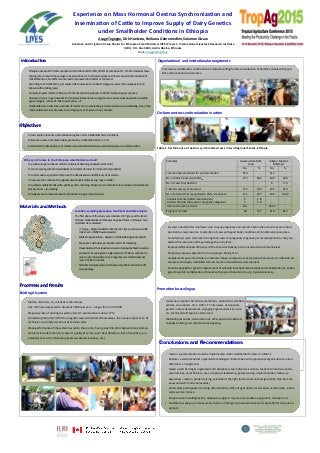Experience on mass hormonal oestrus synchronization and insemination of cattle to improve supply of dairy genetics under smallholder conditions in Ethiopia
- 1. Experience on Mass Hormonal Oestrus Synchronization and Insemination of Cattle to Improve Supply of Dairy Genetics under Smallholder Conditions in Ethiopia Azage Tegegne, Dirk Hoekstra, Berhanu Gebremedhin, Solomon Gizaw Livestock and Irrigation Value Chains for Ethiopian Smallholders (LIVES) Project, International Livestock Research Institute (ILRI), P.O. Box 5689, Addis Ababa, Ethiopia Email: a.tegegne@cgiar.org Introduction Objectives Materials and Methods Processes and Results Existing AI system Organizational and institutional arrangements On-farm oestrus synchronization in action Table 1. Performance of oestrus synchronized cows in two Regional States, Ethiopia Promotion for scaling up Conclusions and Recommendations Ethiopia has about 90 million people and 54 million cattle (CSA, 2012/13) with about 11.2 million breeder cows. Calving rate is about 45%; average milk production is 1.32 litres/cow/day with total annual milk production of 3.81 billion litres; and 82% is consumed or processed into butter at farm level According to CSA (2012/13), per capita milk consumption is about 19 kg/year, lower than averages for sub- Saharan Africa (40 kg/year) Annually Imports USD 12 million worth of milk and milk products to fill the demand-supply variance. However, there is huge potential for dairy development due to large human and livestock population, suitable agro-ecologies, culture of milk consumption, etc. Smallholders are limited by a number of factors from participating in milk production and marketing. One of the major problems is lack of access to and high price of improved dairy animals. to test simple hormonal synchronization regime under smallholder farm conditions, to improve access to improved dairy genetics by smallholder farmers , and to kick-start the development of market-oriented smallholder dairy production system in selected sites. Location, sampling procedure, treatment and data analysis The first phase of this study was conducted in Tigray and Southern Nations, Nationalities and Peoples Regional States in Ethiopia. Two milkshed were selected: In Tigray—Adigrat-Mekelle milk shed in Tigray and Awassa-Dilla milk shed in SNNPR were selected. Market opportunities—Awassa and Mekelle Regional Capitals Experience with dairy production and milk marketing Households with at least two cows and adequate feed resources Cows with CL were given single injection of PGF2α and insemi- nated upon observed estrus. Pregnancy was determined per recturm after 3 months. Statistical analysis were performed using SPSS version 12 Soft- ware package. Mobile, stationary, on-call basis (urban areas) One Technician expected to do about 300 AI per year—ranges from 50 to 1000 Pregnancy rate of existing AI system after 1st insemination is about 27%. Considering that only half of the pregnant cows will deliver female calves, the annual output of an AI technician is estimated at about 41 female calves Weak performance of the system has led to the country having only 350,000 improved dairy animals Problems include technical, transport, quality of semen, poor heat detection, lack of incentive, una- vailability of service off-working hours (weekends, holidays, etc.) Community mobilization, construction of animal handling facility and selection of healthy animals with good BCS and functional corpora lutea Awareness creation; field visits, workshops, publications, (leaflets, articles, case reports, etc.); DVD’s, TV interviews, newspapers, gender in dairy development, engaging high level decision mak- ers, technical staff, experts and farmers. Mobilizing resources, demarcation of other potential milkshed, capacity building, and technical backstopping. Oestrus synchronization could be implemented under smallholder farmers conditions Requires a well planned & organized technological intervention with appropriate organizational and in- stitutional arrangements Needs a well training & organized multi-disciplinary team (livestock science, feeds and nutrition experts, veterinarians, AI technicians, etc.) and proper leadership, good planning, implementation, follow-up Awareness creation, proper training, selection of the right farmers and animals (good BSC, free from dis- eases and with functional ovaries) Community participation involving administration, office of agriculture, local leaders, lead farmers, partic- ularly women farmers Proper animal handling facility, adequate supply of inputs, consumables, equipment, transport, etc. Possible to scaling-up in areas where there is shortage of crossbred animals and potential for dairy devel- opment. Six cows aborted after treatment due to early pregnancy and owners had no idea when they were bred. Good estrus response due to selection of cows with good body condition and functional corpora lutea Some farmers were reluctant to bring their cows for pregnancy diagnosis per rectal palpation as they con- sidered this intrusive and may damage the early fetus. Improved effectiveness efficiency of the AI service delivery (more inseminations/AI technician). Pregnancy rate was about 60 %, due to proper timing of AI. Complements government plan on climate change and green economy (more from less) and milk shed de- velopment through smallholder farmers market-oriented dairy development Could be applied for genetic improvement of selected local beef cattle breeds and rehabilitation of endan- gered breed of multiplication of breeds with special characteristics, eg. trypanotolerance Variables Awasaa-Dale Milk- shed Adigrat-Mekelle Milkshed No. % No. % Total animals presented for synchronization 210 - 212 - No. animals treated with PGF2α 175 83.3 199 93.9 No. of cows that aborted - - 6 3.0 Final No. cows synchronized 175 100 193 97.0 No. of animals that responded to PGF2α treatment 171 97.7 193 100.0 Animals that died (after insemination) Animas that did show up for pregnancy diagnosis 3 5 1.8 2.9 - - - - Interval to oestrus, hours NA - 45.13 - Pregnant animals 94 57.7 119 61.7 Why synchronize in the Ethiopian smallholder context? To produce large number & uniform animals of desired germplasm (kick start) To match calving with feed availability and market demand for milk and milk products To control oestrus period and improve the effectiveness and efficiency of AI service To increase the number of marginalized/endangered breeds (eg. Fogera cattle) To quickly multiply breeds with specific genetic merit (eg. Sheko) and to contribute to resilience of pastoral live- stock systems – re-stocking To mitigate environmental impact of livestock through more from less

